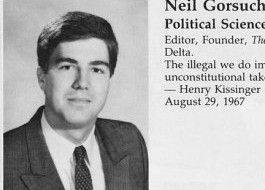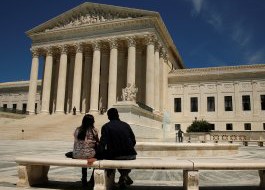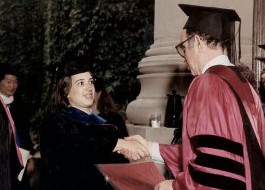
As the Supreme Court’s new term begins, many court watchers have observed that the justices don’t have the usual front-page, nationally important cases on their docket.
By this time a year ago, the Supreme Court had already decided to hear controversial affirmative action, free speech and redistricting cases.
Soon thereafter the justices added important abortion, “Obamacare” and immigration disputes.
By contrast, as of now, other than a potentially controversial “religious liberty” case brought by churches challenging a government program providing grants to repair school playgrounds but excluding religious schools, the court’s docket has few cases Americans will see as important to their lives.
It is anyone’s guess whether the justices will add more as the term goes on.
One of the major reasons the Supreme Court’s docket is so far less explosive than in previous years is that, since Justice Antonin Scalia‘s death in February, the court has been equally divided between four Republicans and four Democrats.
In most cases – although certainly not all – this division corresponds to four conservative and four liberal votes.
Due to this four-to-four alignment, the justices may not want to hear cases where a voting deadlock is inevitable. In cases where the vote is tied, the lower court decision stands as if the Supreme Court had never heard the case.
The justices likely feel it is a waste of time and resources to consider cases which in all likelihood will end in a tie.
Moreover, as Professor Steve Wermiel observed for SCOTUS Blog, given how long it usually takes for the Senate to approve a Supreme Court nominee, even if the Senate were to act after the election, it is likely the court won’t have a ninth justice until after this term is over.
Striking down laws: back to basics
Although I have written a number of essays arguing that this four-to-four Supreme Court is a good thing, most court watchers are lamenting what they see as an incomplete, divided legal institution.
This conventional wisdom, however, pays too little attention to what the current eight-member court tells us about how the justices should decide cases and even which disputes they decide to hear.
At the heart of every Supreme Court constitutional case is the same essential issue: Under what circumstances should five justices impose a national rule binding on all 50 states and the American people?
 Reuters
Reuters
Issues such as how or if the government may limit the funding of state and federal political campaigns, whether public universities may use racial criteria in admissions or whether all 50 states must recognize same-sex marriage all involve the question: “Who should decide?”
Is it political decision-makers at the local, state or federal levels? Or is it five judges sitting permanently in our nation’s capital?
The court’s job is emphatically not to overturn laws solely because the justices think they represent bad policy or to announce rules the justices think will make us into a better society. Instead, the court is supposed to determine whether the law or practice being challenged in any given case violates the United States Constitution.
In the most famous historical document discussing this question, written before the Constitution was ratified, Alexander Hamilton quite pointedly observed that the justices should only invalidate laws that are at an “irreconcilable variance” with the Constitution, and only if the justices exercise “judgment” not “will.”
Where legal judgment is impossible – for example, when the Constitution is silent and history contested – the justices should allow other political decision-makers to do their jobs.
 Kevin Lloyd, right, kisses his boyfriend, Breyer Conroy, left, in the San Francisco Gay Pride Parade, June 28, 2015 in San Francisco, California. The 2015 pride parade comes two days after the U.S. Supreme Court's landmark decision to legalize same-sex marriage in all 50 states. Max Whittaker/Getty Images
Kevin Lloyd, right, kisses his boyfriend, Breyer Conroy, left, in the San Francisco Gay Pride Parade, June 28, 2015 in San Francisco, California. The 2015 pride parade comes two days after the U.S. Supreme Court's landmark decision to legalize same-sex marriage in all 50 states. Max Whittaker/Getty Images
The problem with Hamilton’s advice is that most constitutional law cases involve vague phrases like “equal protection,” “due process,” or “free exercise of religion,” and raise complex modern issues that cannot be resolved by historical analysis.
Therefore, despite Hamilton’s admonition, the justices have a long history of overturning the decisions of political officials even where constitutional text and history do not clearly suggest such a result.
There are plenty of examples to choose from.
Liberals would point to Citizens United v. FEC (corporations have same rights to spend money on political campaigns as people) and Shelby County v. Holder (overturning a key part of the Voting Rights Act) as examples of cases that greatly impacted our political system, and for the worse, without solid legal grounding.
Conservatives would point to Obergefell v. Hodges (states must recognize same-sex marriage) and Roe v. Wade (protecting women’s right to abortion) as illegitimate cases that involved “will” not “judgment.”
Each side could point to many more decisions explained better by the personal value judgments of the justices than text, history or prior case law.
The most important rule
Justice William Brennan used to ask his law clerks to identify the most important rule in constitutional law. According to UCLA Law Professor Adam Winkler, this is what would happen next:
The clerks would ponder the question and respond, “freedom of speech,” “separation of church and state,” or “separation of powers.” No, Brennan would respond with a wry smile. And then he would hold out one hand with his fingers outstretched. “Five,” he would say.A justice needs five votes to make a majority on the nine-member court. With five votes, a justice could do anything. Of course, Justice Brennan was assuming a nine-member court, a number established by Congress in 1869 (the Constitution is silent on the requisite number of justices).
 Alexander Hamilton. Wikimedia Commons
Alexander Hamilton. Wikimedia Commons
Constitutional law should be infused with more legal content than “because five judges think so.” Unfortunately, the history of the court suggests otherwise, and that is why it is so important for Americans to understand fully the implications of a four-to-four evenly divided court.
For the justices to issue a decision this term, at least one of the liberal justices will have to side with the four conservatives or one of the conservative justices will have to side with the four liberals.
This need to cross party lines is a good thing because partisan values and ordinary political judgments will play less of a role when judges of different pedigrees, and who generally hold different values, have to agree in order for the institution to produce a decision.
Maybe a good answer to the question of when the court should be allowed to impose a national rule on the rest of us is that it should do so only when there is at least some agreement among justices of different political stripes that such a rule is essential to our constitutional order.
If the rule is not essential, perhaps the justices should act with more humility. That is much more likely to happen on an equally divided four-to-four Supreme Court than on a court where five or more justices can unilaterally impose their will.
In fact, at the beginning of the 20th century, there were many court commentators who believed the justices should not decide important cases by a five-to-four vote even on a nine-member court.
I am under no illusion that my proposals that the Senate change the number of justices to eight, and adopt a rule that a retiring or deceased justice has to be replaced with a justice of the same political party, will ever be implemented.
But the longer we have an evenly divided court, the more likely it will be the justices will act more modestly, and take more heed of Hamilton’s warning that they exercise “judgment” not “will.”
Both political parties, the Congress, the president, and the American people have a strong vested interest in teaching all of the justices those important lessons.
By Eric Segall, Kathy & Lawrence Ashe Professor of Law, Georgia State University
This article was originally published on The Conversation. Read the original article.




